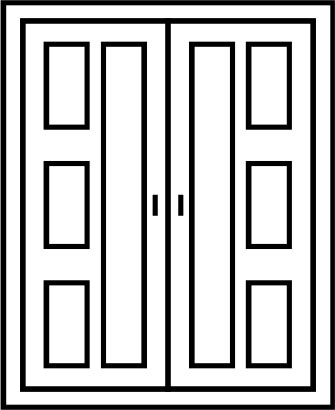Key Takeaways: How to Measure a Door
Here is a step-by-step summary of the measurement process described in the article:
- Gather Tools: You will need a measuring tape, a level, a pencil, and a notepad.
- Measure Width: Measure the width of the door slab at three different points: the top, middle, and bottom. Use the largest of these three measurements.
- Measure Height: Measure the height on both the left and right sides of the door. Use the tallest measurement to ensure the door will fit.
- Measure Thickness: Measure the edge of the door to find its thickness. Standard interior doors are typically 1-3/8 inches thick, and exterior doors are 1-3/4 inches thick.
- Determine Door Swing (Handing): Stand on the “outside” of the door (the side where the door swings away from you).
- If the hinges are on your left, it is a left-hand door.
- If the hinges are on your right, it is a right-hand door.
- Measure the Rough Opening: To ensure a pre-hung door will fit, measure the frame’s opening. Measure the width from stud to stud and the height from the floor to the top of the opening.
- Avoid Common Mistakes: The biggest errors are not measuring at multiple points, forgetting to measure the door’s thickness, and choosing the wrong door swing (handing).
Tools Needed
Pro Tip: Using a digital measuring tape can improve accuracy and reduce errors, especially for those unfamiliar with traditional tape measures.
Before you begin measuring, gather the following tools:
- Measuring tape
- Level
- Pencil
- Notepad or phone to record measurements
Step-by-Step Guide on Measuring a Door
Step 1: Measure the Door Width
- Using a measuring tape, measure the width of the door at three points: top, middle, and bottom.
- Record the largest measurement to ensure the new door will fit properly.
- Standard door widths typically range from 28 to 36 inches in residential homes.
Pro Tip: If your measurements vary significantly between points, your door frame may be out of square. In such cases, consider using a slightly smaller door and adjusting with shims during installation.
Step 2: Measure the Door Height
- Measure the height from the top edge to the bottom edge of the door.
- Take measurements on both the left and right sides to check for inconsistencies.
- Use the tallest measurement for accuracy.
- Standard door heights are typically 80, 84, or 96 inches.
Pro Tip: If you are replacing an older door, check for clearance at the bottom, especially if flooring has been replaced or adjusted over time.
Step 3: Measure the Door Thickness
Pro Tip: If your door has panels or beveled edges, measure at the thickest point to ensure you get the correct measurement.
- Place the measuring tape on the edge of the door and measure its thickness.
- Standard door thicknesses are 1-3/8 inches for interior doors and 1-3/4 inches for exterior doors.
Step 4: Measure the Door Frame (Rough Opening)
Pro Tip: Check for any warping in the door frame using a level. A warped frame may require adjustments before installing a new door.
- Measure the width and height of the door frame or rough opening where the door will be installed.
- Width: Measure from stud to stud inside the opening.
- Height: Measure from the floor to the top of the opening.
- Compare these measurements with the door size to ensure compatibility.
Step 5: Measure the Door Swing (Handing)
Pro Tip: If you’re unsure about the handing of your door, try opening it as if entering the room—this can help you visualize the correct swing direction.
- Stand on the outside of the door (the side where the door swings away from you).
- If the hinges are on the left, it’s a left-hand door.
- If the hinges are on the right, it’s a right-hand door.
- Correct door swing ensures smooth operation and proper clearance.
Common Mistakes to Avoid
Pro Tip: Always take measurements twice to ensure accuracy. A simple recheck can prevent costly errors and return trips to the store.
- Not measuring at multiple points – Door frames and floors can be uneven.
- Ignoring door thickness – A mismatch can prevent proper installation.
- Forgetting to check the swing direction – Choosing the wrong handing can cause clearance issues.
- Not accounting for trim and clearance – Ensure there’s enough space for smooth door operation.
Additional Tips for Accurate Measurements
- Double-check measurements before purchasing a new door.
- Write down each measurement to avoid errors.
- Measure irregular frames carefully – Use a level to check for out-of-square openings.
- Consult a professional if unsure about complex door replacements.
Types of Doors and Their Measurement Differences
Interior vs. Exterior Doors
- Interior doors are typically 1-3/8 inches thick, while exterior doors are 1-3/4 inches thick for added durability and insulation.
- Exterior doors require precise measurements to ensure proper sealing against the elements.
French Doors, Sliding Doors, Barn Doors, and Bi-Fold Doors
- French Doors: Measure the total width of both doors together and account for the frame clearance.
- Sliding Doors: Measure the entire width and height of the door opening, including the track system.
- Barn Doors: Measure the door opening and add 1-2 inches on each side for proper coverage.
- Bi-Fold Doors: Measure the width and divide by the number of panels for an accurate fit.
Hollow Core vs. Solid Core Doors
- Hollow Core Doors: Lighter, often used for interior applications, easier to modify.
- Solid Core Doors: Heavier, better for soundproofing and durability, often requiring reinforced hinges.
How to Measure for a Custom Door
When Standard Sizes Don’t Work
- Some doorways do not conform to standard sizes, requiring a custom door.
- Measure the opening carefully and consult with a professional to ensure proper fit.
Adjustments for Non-Standard Door Frames
- If the frame is uneven, measure at multiple points and use the largest measurement.
- Consider shimming the frame or ordering a door with a custom cut for an exact fit.
How to Measure for a Fire-Rated Door
Understanding Fire Code Requirements
- Fire-rated doors must meet specific local and national fire code regulations.
- Check your local building codes to determine the required fire rating (e.g., 20, 45, 60, or 90 minutes).
- Ensure the door frame and hardware are also fire-rated for proper compliance.
Thickness and Material Considerations
- Fire-rated doors are typically 1-3/4 inches thick for better fire resistance.
- Materials include solid core wood, steel, or composite fire-resistant materials.
- Verify manufacturer specifications to ensure compliance with fire safety standards.
How to Measure a Door for Accessibility (AODA Compliance)
When measuring for accessibility in Ontario, you must follow the requirements of the Accessibility for Ontarians with Disabilities Act (AODA) and the Ontario Building Code (OBC), not the American ADA.
Here are the key measurements you must check for compliance:
- Clear Opening Width: This is the most critical measurement. It is not the width of the door itself, but the usable space when the door is open (measured at a 90-degree angle).
- Requirement: A barrier-free door must provide a minimum clear opening width of 860 mm (approx. 34 inches). An 860 mm door slab will not provide this, as the door’s own thickness and the hinges will be in the way. You must measure the clear space between the face of the open door and the stop on the latch side.
- Maneuvering Clearance (Clear Space): There must be enough clear floor space at the door to allow a person using a wheelchair or other mobility device to approach and open it.
- Pull Side (Door swings toward you): You must have a clear space of at least 600 mm (24 inches) on the latch side of the door.
- Push Side (Door swings away from you): You must have a clear space of at least 300 mm (12 inches) on the latch side of the door.
- Threshold Height: The threshold at the bottom of the door must be as low as possible.
- Requirement: The maximum height for a threshold is 13 mm (1/2 inch). If it is between 6 mm and 13 mm high, it must be beveled.
- Hardware: The type and location of the handle are strictly regulated.
- Type: Hardware must be operable with a closed fist and minimal force. This means lever-style handles or U-shaped pulls are compliant, while round doorknobs are not.
- Height: The handle or opening device must be mounted between 900 mm (35.5 inches) and 1100 mm (43.3 inches) from the finished floor.
How to Measure and Install a Pet Door
Choosing the Right Size for Your Pet
- Measure your pet’s shoulder height and width to select the correct pet door size.
- Add 1-2 inches to both measurements for comfort and easy access.
Best Placement in an Existing Door
- Install the pet door at least 2 inches above your pet’s shoulder height.
- Ensure the bottom of the pet door is low enough for easy stepping but high enough to prevent drafts.
- Use a level and follow manufacturer instructions for proper installation.
Conclusion
Accurate door measurements are crucial for a smooth installation and a perfect fit. By following these steps, you can confidently measure your door and avoid common mistakes. Before making a purchase, always double-check your measurements. If you’re dealing with an irregular door frame or unsure about any step, consulting a professional can save time and effort.
Need help choosing the right door for your home? Contact a professional door installer for expert guidance!



